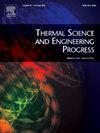Analysis of immersion cooling performance for LiFePO4 battery packs: coolant effect and optimization
IF 5.4
3区 工程技术
Q2 ENERGY & FUELS
引用次数: 0
Abstract
Compared to air cooling and cold plate liquid cooling, immersion cooling is an advanced and highly efficient thermal management technology with advantages such as lower thermal resistance, reduced maintenance costs, and lower energy consumption. The immersion liquid (i.e. the coolant) is crucial to the cooling system’s performance, and key thermophysical properties of the immersion liquid, i.e. viscosity, density, specific heat capacity, and thermal conductivity, collectively determine the system heat dissipation efficiency. While literature work focuses more on benchmarking the established coolants as immersion liquid, progress in developing more advanced immersion liquids is constrained by insufficient reference data for multi-property optimization. In this study, a cost-effective approach integrating 3D transient computational fluid dynamics (CFD) and response surface analysis (RSA) is employed to investigate the impact of immersion liquid properties on the thermal performance of an immersion-cooled 280Ah LiFePO4 prismatic module (1P52S). Separate response surface models are established for the first time to quantify the effects of thermophysical properties on the cooling performance of both flammable and non-flammable dielectric fluids. Furthermore, an optimization process is conducted to identify the optimal cooling fluid parameters, achieving a temperature difference within the battery module of less than 2 K. The obtained findings provide insights and valuable data to the selection and optimization of immersion liquids for the practical lithium-ion battery immersion cooling systems.
LiFePO4电池组浸没冷却性能分析:冷却剂效果及优化
与风冷、冷板液冷相比,浸没式冷却是一种先进、高效的热管理技术,具有热阻小、维护成本低、能耗低等优点。浸没液(即冷却剂)对冷却系统的性能至关重要,浸没液的关键热物理性能,即粘度、密度、比热容和导热系数,共同决定了系统的散热效率。虽然文献工作更多地侧重于将已建立的冷却剂作为浸入式液体的基准,但开发更先进的浸入式液体的进展受到多性能优化参考数据不足的限制。本研究采用三维瞬态计算流体动力学(CFD)和响应面分析(RSA)相结合的高性价比方法,研究了浸没液体特性对浸没冷却280Ah LiFePO4棱镜模块(1P52S)热性能的影响。首次建立了单独的响应面模型,以量化热物理性质对可燃和非可燃介质流体冷却性能的影响。进一步进行优化过程,确定最佳冷却液参数,实现电池模块内部温差小于2 K。研究结果为实际锂离子电池浸没冷却系统中浸没液的选择和优化提供了有价值的数据。
本文章由计算机程序翻译,如有差异,请以英文原文为准。
求助全文
约1分钟内获得全文
求助全文
来源期刊

Thermal Science and Engineering Progress
Chemical Engineering-Fluid Flow and Transfer Processes
CiteScore
7.20
自引率
10.40%
发文量
327
审稿时长
41 days
期刊介绍:
Thermal Science and Engineering Progress (TSEP) publishes original, high-quality research articles that span activities ranging from fundamental scientific research and discussion of the more controversial thermodynamic theories, to developments in thermal engineering that are in many instances examples of the way scientists and engineers are addressing the challenges facing a growing population – smart cities and global warming – maximising thermodynamic efficiencies and minimising all heat losses. It is intended that these will be of current relevance and interest to industry, academia and other practitioners. It is evident that many specialised journals in thermal and, to some extent, in fluid disciplines tend to focus on topics that can be classified as fundamental in nature, or are ‘applied’ and near-market. Thermal Science and Engineering Progress will bridge the gap between these two areas, allowing authors to make an easy choice, should they or a journal editor feel that their papers are ‘out of scope’ when considering other journals. The range of topics covered by Thermal Science and Engineering Progress addresses the rapid rate of development being made in thermal transfer processes as they affect traditional fields, and important growth in the topical research areas of aerospace, thermal biological and medical systems, electronics and nano-technologies, renewable energy systems, food production (including agriculture), and the need to minimise man-made thermal impacts on climate change. Review articles on appropriate topics for TSEP are encouraged, although until TSEP is fully established, these will be limited in number. Before submitting such articles, please contact one of the Editors, or a member of the Editorial Advisory Board with an outline of your proposal and your expertise in the area of your review.
 求助内容:
求助内容: 应助结果提醒方式:
应助结果提醒方式:


